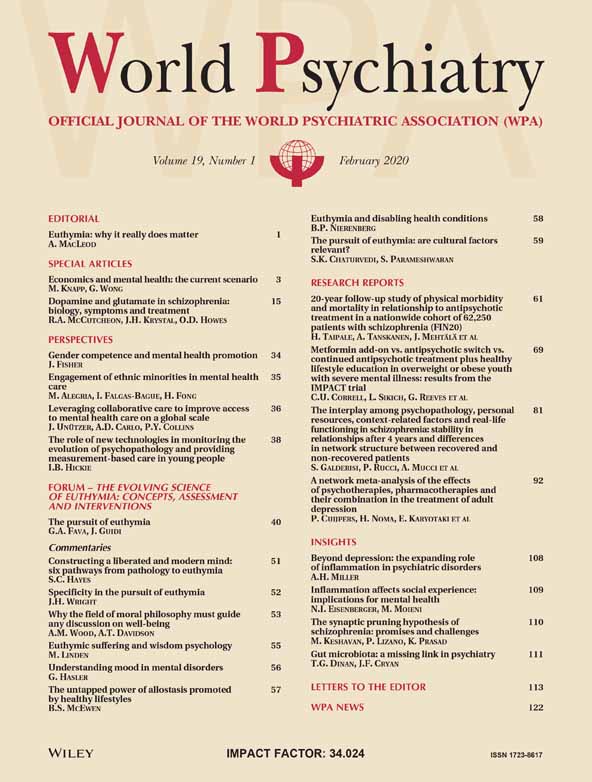Euthymia and disabling health conditions
The focus of positive psychology can be seen as an attempt to address the philosophical question first put forth by the ancient Greeks: “what does it mean to live a good life?” . When people's physical body changes and the person-environment interaction significantly alters due to a chronic illness/disability condition, this question can take on additional dimensions and importance.
For example, after a stroke or a spinal cord injury, people often wonder what the future has now in store for them. Questions such as “what am I supposed to do now?” are frequent and applied to both their personal and work lives. Rates of depression within this population range between 10 and 60%1, and individuals with a spinal cord injury have rates of post-traumatic stress disorder (PTSD) as high as 14% six months post-injury2.
People with spinal cord injury who develop depression are likely to experience longer hospitalizations, increased pain, higher financial expenditures, as well as decreased self-efficacy and diminished quality of life3. They need to maintain an extensive and complex self-care regimen in order to prevent complications such as pressure ulcers, skin injuries and urinary tract infections. Active self-care can significantly mitigate these negative outcomes; however, sustaining a self-care regimen when living with depression is quite challenging.
Once entering rehabilitation to address a disabling health condition, the most important goal is to help individuals attain the highest possible levels of well-being. Mindfulness interventions can significantly reduce depression, anxiety and pain in individuals with spinal cord injury4. Utilizing a variety of positive psychology interventions in individuals with chronic pain has been found to result in significant improvements in pain intensity, pain interference, life satisfaction, positive affect, and depression, when compared to a control group. Importantly, these improvements persisted in a 2.5-month follow-up5.
Researchers who have examined more general factors of quality of life and adjustment to chronic illness/disability have found that those who adjust well perceive their current life as in continuity with their personal biography, and focus on their continued capability and competence rather than solely on areas of inadequacy and limitation. These individuals acknowledge that they are the same person as they were pre-injury, but just have more challenges6.
Leisure activities such as good acts (e.g., volunteering) or good habits (e.g., regular exercise) have likewise been found to contribute to post-traumatic growth, by providing opportunities to discover unique abilities and hidden potential, build companionship and meaningful relationships, make sense of the traumatic experience, find meaning in everyday life, and generate positive emotions7. It is of interest to note that these elements mirror the dimensions of well-being described by Fava and Guidi8.
Applying the concept of euthymia to persons living with a disability argues for a more comprehensive appreciation of the strengths remaining in each person's “new normal” circumstances while maintaining a focus on the perceived difficulties.
With euthymia emphasized, it would be expected that individuals would be more likely to expend increased effort in the rehabilitation process, possibly resulting in increased engagement in self-care. This, in turn, could lead to decreased future hospitalizations and improved overall quality of life. In this manner, individuals with increased euthymia could be expected to make further functional improvements after rehabilitation.
Given the current emphasis on both preventing disease and increasing levels of health, it is even more important to learn how to facilitate these outcomes. Unfortunately, this hoped-for state of affairs currently remains an unanswered set of empirical questions that beg to be addressed with data. Luckily, these studies could be facilitated by currently available valid and reliable psychometric instruments to assess the various elements of euthymia8.
It is understood that adjusting to a life with a disability is challenging. As R. Trieschmann stated in writing about the more personal dimensions of living with a spinal cord injury, “people with this injury are a fairly heterogeneous group, but they have one thing in common: the disability penalizes them and reduces their freedoms”9. By increasing euthymic adaptations, this very real “penalization” and “reduction of freedom” could be understood and reacted to in a different light. The use of this type of intervention could, and should, be expanded to other conditions such as limb loss, brain injuries, and a variety of chronic illnesses.
Utilizing a euthymic framework could lead to a significant improvement in quality of life and well-being in a rehabilitation population. In such a model, building up new psychological strengths can facilitate the adaptation to the substantial life changes accompanying chronic illness/disability.




